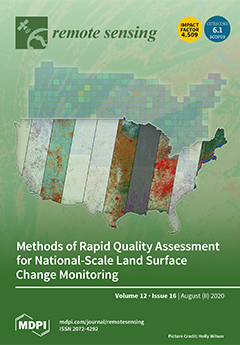Changes in vegetation distribution, structure, and function can modify the canopy properties of terrestrial ecosystems, with potential consequences for regional and global climate feedbacks. In the Arctic, climate is warming twice as fast as compared to the global average (known as ‘Arctic amplification’),
[...] Read more.
Changes in vegetation distribution, structure, and function can modify the canopy properties of terrestrial ecosystems, with potential consequences for regional and global climate feedbacks. In the Arctic, climate is warming twice as fast as compared to the global average (known as ‘Arctic amplification’), likely having stronger impacts on arctic tundra vegetation. In order to quantify these changes and assess their impacts on ecosystem structure and function, methods are needed to accurately characterize the canopy properties of tundra vegetation types. However, commonly used ground-based measurements are limited in spatial and temporal coverage, and differentiating low-lying tundra plant species is challenging with coarse-resolution satellite remote sensing. The collection and processing of multi-sensor data from unoccupied aerial systems (UASs) has the potential to fill the gap between ground-based and satellite observations. To address the critical need for such data in the Arctic, we developed a cost-effective multi-sensor UAS (the ‘
Osprey’) using off-the-shelf instrumentation. The
Osprey simultaneously produces high-resolution optical, thermal, and structural images, as well as collecting point-based hyperspectral measurements, over vegetation canopies. In this paper, we describe the setup and deployment of the
Osprey system in the Arctic to a tundra study site located in the Seward Peninsula, Alaska. We present a case study demonstrating the processing and application of
Osprey data products for characterizing the key biophysical properties of tundra vegetation canopies. In this study, plant functional types (PFTs) representative of arctic tundra ecosystems were mapped with an overall accuracy of 87.4%. The
Osprey image products identified significant differences in canopy-scale greenness, canopy height, and surface temperature among PFTs, with deciduous low to tall shrubs having the lowest canopy temperatures while non-vascular lichens had the warmest. The analysis of our hyperspectral data showed that variation in the fractional cover of deciduous low to tall shrubs was effectively characterized by
Osprey reflectance measurements across the range of visible to near-infrared wavelengths. Therefore, the development and deployment of the
Osprey UAS, as a state-of-the-art methodology, has the potential to be widely used for characterizing tundra vegetation composition and canopy properties to improve our understanding of ecosystem dynamics in the Arctic, and to address scale issues between ground-based and airborne/satellite observations.
Full article





